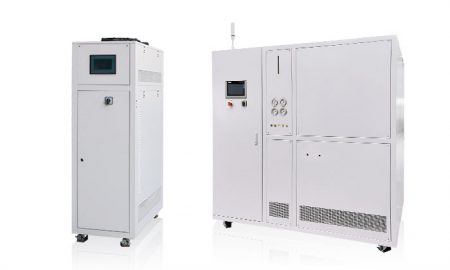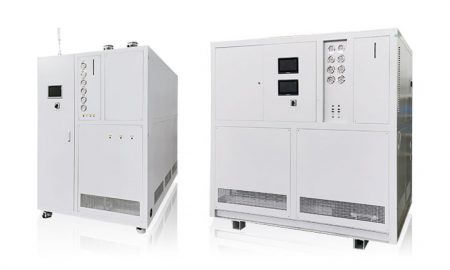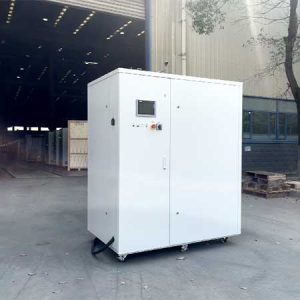Best Electric Vehicle (EV) Battery Cooling System Chiller
完璧な温度制御ソリューションについては、今すぐお問い合わせください。
The heat dissipation system in the Electric Vehicle (EV) power battery is particularly important, and the new energy battery chiller can cool down the power battery pack. Currently, there are three battery cooling methods: air cooling, water cooling and direct cooling. In the air-cooling mode, the heat dissipation system uses natural wind or fans, and cooperates with the car’s own evaporator to cool the battery; in the water-cooling mode, the radiator is generally coupled to the refrigeration cycle system, and the heat of the battery is taken away through the refrigerant. ; In direct cooling mode, the cooling system uses the principle of latent heat of refrigerant evaporation to establish an air conditioning system in the vehicle or battery system. The evaporator of the air conditioning system is installed in the battery system. The refrigerant evaporates in the evaporator and quickly and effectively Take away the heat from the battery system to achieve cooling.
The object tested by Electric Vehicle (EV) Battery Cooling System Chiller is connected to a test platform adapter. The interior of the component is cooled and heated using an ethylene glycol aqueous solution. The test component needs to undergo a specific temperature change curve and the temperature change is recorded.

The temperature change range is usually from -40 to 100°C (can be extended to 150°C). While controlling the temperature, you can also choose to control the flow or pressure; it is equipped with a powerful circulation pump to ensure the delivery of high-viscosity liquids; Frequency conversion adjustment or proportional adjustment valve is used to control the flow output to achieve high-precision control of the total range adjustment.
Our Electric Vehicle (EV) Battery Cooling System Chiller is suitable for the new generation of energy battery packs. It can effectively test the strong environmental adaptability of the battery pack, improve the safety and reliability of the vehicle, and ensure the vehicle’s performance in a variety of complex environments. of good operation. It is widely used in performance testing of motors and battery packs, rapid temperature rise and cooling thermal shock tests, and various environmental adaptability evaluation tests.
New energy battery companies pay more attention to battery arrangement, thermal management system, and battery management system performance to ensure that each battery unit is under supervision and its status data can be fed back and processed at any time. For a single small battery unit, the liquid cooling system can specifically cool each battery unit, reducing the temperature difference between each other, and also relatively reducing the risk of battery self-ignition.
The new energy battery chiller controls the temperature of the battery pack between 10-35°C. Even in an ultra-low temperature environment of minus 30°C, it can be charged normally without affecting the cruising range. The new generation of battery pack water-cooling technology realizes rapid low-temperature heating of the battery. Under the conditions of ambient -30℃ and battery cell -15℃, the battery can be heated to above 10℃ within 40 minutes. At the same time, its excellent battery cooling performance meets the requirements of high-speed Accelerate charging and continue driving, and the maximum battery temperature should be controlled below 35°C.
The use of new energy battery chiller water cooling technology can better solve the problems that new energy vehicles currently face, such as reduced cruising range at low temperatures and the inability to charge at low temperatures, improve users’ car experience, and promote the popularity of new energy vehicles.
Eメール info@lneya.com WeChat ID: +8615251628237 WhatsApp: +86 17851209193

ヒート/クール温度・流量制御システム
(カスタムデザイン)
車両品質テスト用温度シミュレーション:バッテリー寿命テスト、燃料噴射装置/モーターテストベンチ、エアバッグテスト、コンポーネントテストベンチなど。
| 温度範囲 | -25°C ~ +100°C | -40°C ~ +100°C | 0°C ~ +100°C | -40°C ~ +135°C | |||||
| 冷却能力 | 2.8~38kW | 1.2〜60kW | 1.8〜60kW | 4〜60kW | |||||
| 注: -150℃の~ +350℃からの温度較差および冷却容量はカスタマイズすることができる | |||||||||
温度/圧力/流量を個別に制御可能
1&2: 2つのグループ制御のための1つの機械
| 温度範囲 | -40 ~ +100℃ 1&2 | 0 ~ +100℃ 1&2 | |||||||
| 冷却能力 | 1.8kW*2〜60kW*2 | 1.8kW*2〜60kW*2 | |||||||
| 注: -150℃の~ +350℃からの温度較差および冷却容量はカスタマイズすることができる | |||||||||
温度は一定、圧力・流量は個別に制御可能
1&3: 3つのグループコントロールのための1つの機械
1&6:1台で6グループをコントロール
| 温度範囲 | -40 ~ +100℃ 1&2 | -40 ~ +100℃ 1&3 | -40 ~ +100℃ 1&6 | -20 ~ +100℃ 1&6 | 0 ~ +100℃ 1&2 | 0 ~ +100℃ 1&3 | 0 ~ +100℃ 1&6 | ||
| 冷却能力 | 2.5〜60kW | 4〜60kW | 10 ~ 60kW | 10 ~ 60kW | 7~60kW | 11~60kW | 18 ~ 60kW | ||
| 注: -150℃の~ +350℃からの温度較差および冷却容量はカスタマイズすることができる | |||||||||

オイルチラー
(カスタムデザイン)
車両品質テスト用温度シミュレーション:バッテリー寿命テスト、燃料噴射装置/モーターテストベンチ、エアバッグテスト、コンポーネントテストベンチなど。
| 温度範囲 | 0℃ ~ +160℃ | +5℃ ~ +135℃ | |||||||
| 冷却能力 | 11~60kW | 15~38kW | |||||||
| 注: -150℃の~ +350℃からの温度較差および冷却容量はカスタマイズすることができる | |||||||||

電子ポンプ用冷暖房システム
(カスタムデザイン)
| 温度範囲 | -40°C ~ +135°C | ||||||||
| 冷却能力 | 60kWまで | ||||||||
| 注: -150℃の~ +350℃からの温度較差および冷却容量はカスタマイズすることができる | |||||||||

高温・低温バッテリー試験室
(カスタムデザイン)
| 温度範囲 | -40℃ ~ +100℃ | -40℃ ~ +100℃ | |||||||
| 冷却能力 | 1.8 ~ 7.5kW | 4~15kW | |||||||
| 注: -150℃の~ +350℃からの温度較差および冷却容量はカスタマイズすることができる | |||||||||

自動車用直接冷却または加熱システム
(カスタムデザイン)
| 種類 | 直接冷却 | ダイレクト・クーリング&ヒーティング | |||||||
| 冷却能力 | 5~10kW | 5~10kW | |||||||
| 注: -150℃の~ +350℃からの温度較差および冷却容量はカスタマイズすることができる | |||||||||

バッテリーエネルギー貯蔵システム用液体冷却
(カスタムデザイン)
| 種類 | コンバーティング・ステーション用 | 蓄電池用 | 充電ステーション用 | ||||||
| 冷却能力 | 45kW | 5 ~ 8.5kW | 4kW | ||||||
| 注: -150℃の~ +350℃からの温度較差および冷却容量はカスタマイズすることができる | |||||||||
 LNEYA
LNEYA
 简体中文
简体中文



















































































